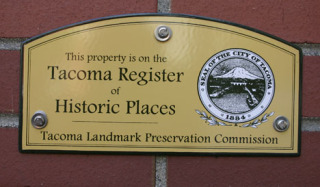One could argue the single area of Tacoma related to historic preservation that will receive the most attention and biggest overhaul this year is the City’s own historic preservation program.
In December, City Council allocated $200,000 in its 2009-10 biennial budget toward completing a comprehensive historic preservation plan and funding additional historic resource inventories, updating existing inventories, and digitizing data.
That work was laid out in detail Tuesday during a presentation to Tacoma City Council during its noon study session. According to Historic Preservation Officer Reuben McKnight, the presentation aimed to provide an overview of the work item requests received last year, and provide a plan for addressing those items over the next 18 months.
Here are some of the initiatives the City’s historic preservation office will tackle in 2009-2010:
- Establishment of additional historic districts / Residents in three Tacoma neighborhoods — the “Wedge,” Whitman, and the West Slope — have contacted the City with an interest in designating their neighborhoods as historic districts. This year, the historic preservation office will explore how to better streamline a process to serve residents interested in creating historic districts. “There are currently questions that are not totally resolved,” said McKnight. “How are they made? Who carries the cost? How can the planning and landmarks preservation commissions be better coordinated?”
- Updates to the city’s historic property inventory / A major inventory was conducted between 1977 and 1982. Since 2003, the inventory has been updated periodically as funding has been available. According to McKnight, a majority of data are old or incomplete, methodology has changed, and the 50-year cutoff date for historic properties has moved since the last survey. “It really needs to be thoroughly vetted and made complete, and entails a significant overhaul,” said McKnight.
- Revised policy for naming historic areas / In 1989, City Council adopted a resolution guiding citizens on how to request naming historically significant areas of town. “The indications are that it may be time to take a look at how that works and ways to improve it,” said McKnight. One effort that could benefit from a policy improvement is a plan under way to re-name D Street Overpass to Delin Crossing in honor of Nicholas Delin and his 19th Century timber mill once located on Tacoma’s tide flats.
- Demolition permit review process / Originated by the advocacy group Historic Tacoma, one proposed idea is for a demolition review ordinance that calls for a developer seeking a demolition permit for a building 50 years or older to also submit photographs of the building’s condition and documentation of its age to the city’s historic preservation office and landmarks preservation commission for review. Reviews would not prevent demolition of older structures, but would be effective in assessing the historic significance of the structure and the impact of demolition on neighborhood character. If the structure is deemed historically significant and eligible for the city’s register, a defined period of time would be set during which a nomination could be submitted. McKnight said the goal is to provide City Council several alternatives for a demolition review process.
The City is also expected to explore procedures for “de-listing” historic properties; code enforcement for historic properties and districts; a policy for commemorative markers and monuments; a review of whether incentives for landmarking historic properties are effective; a comprehensive survey of religious structures; and a city-wide archaeological study.
The topic of historic districts received the most attention from councilmembers because it can be a controversial issue. Preservationists want to keep a section of the city protected for future generations; homeowners fear the designation will cripple their abilities to make modifications to their homes. Among the three historic districts on the city’s register, only one is a residential historic district (North Slope). In 1999, an effort to create a historic district in Old Town failed after homeowners turned out en masse at City Hall to protest the idea.
“[Old Town] was a tremendous controversy,” recalled Tacoma Mayor Bill Baarsma during Tuesday’s meeting. “We really have to find a way of gauging the support. You’re going to get vociferous pushback from people in the area. It should be a strong majority of people who live in the area committed to making that work.”
Councilmember Mike Lonergan was concerned that staff would spend time and energy up front on a topic that can be “highly controversial and impose restrictions on property rights” only to see there isn’t enough community support for City Council to comfortably approve the creation of a particular district. He was also concerned over the number of neighborhoods seeking historic district status.
“The idea of historical significance can be lost,” said Councilmember Mike Lonergan. “If everyone is special then no one is special. We’re going to have to really focus.
“I’m wondering if we’re not starting to go in a direction where we have a long line of people wanting to declare their building or whole section of the city historic,” he added.
And he asked where historic preservation fit into everyday needs for the average Tacoman. “Many people live in a historic house, but they may be saying just fix my historic street,” he said. “Use resources and energy on obvious needs.”
McKnight agreed historic districts are touchy. But he noted that recent interest in historic districts have come from residents within the proposed district boundaries. “It’s important to restate none of these historic district proposals originated from the City,” he said. “They all came from neighborhood groups. When and if these get to formal review, there will be a very thorough public process.”
Councilmember Julie Anderson said she supported residents’ interests in historic districts.
“I’m glad that grass roots activism has initiated these requests,” she said. “The amount of money staff have estimated to assist with inventory and vetting of historic districts is a very low cost. I respect Councilmember Lonergan’s remarks, but I look at it as preserving a fabric of the city. They may be street after street of very ordinary houses, but they tell a story of the evolution of our working class and development of neighborhoods. I’m glad we have vehicle to allow citizens to work it out. I also respect the fact that should citizens decide they want to create districts, it comes at a cost. There are restrictions. I think it’s a worthwhile experiment and look forward to how it turns out. I suspect 100 years from now we will be so lucky to have these historic districts. It’s preserving whole areas of cloth within our city.”
This week’s discussion traces back to last year, when the historic preservation office began receiving queries about the program from citizens and councilmembers.
In November, the Index reported the program could undergo some major revisions in the New Year as city officials prepare to embark on the development of a citywide historic preservation plan.
In a memo written in November by Community and Economic Development Director (CEDD) Ryan Petty to City Manager Eric Anderson, Petty cited a need to examine the program in order to respond to recent inquiries from residents and councilmembers.
“Over the last several months, the City Council has received several requests from the community for improvements and additions to City policies and procedures relating to Historic Preservation,” wrote Petty in the Nov. 10 memo. “In addition, staff and the Landmarks Preservation Commission have identified the need to address other important areas related to the City’s historic preservation program.”
“This doesn’t happen often,” McKnight told the Index in November. “I think it shows a heightened level of interest in historic preservation. The program is 30 to 35 years old. Since 2005, we haven’t made many updates at all. I think we can be much more detailed and focused.”
McKnight cited a busy year for historic preservation in 2008 as one reason for the policy work.
“There are a lot of policy areas that we can always improve,” he added. “Certain things we don’t have in our code presently that we have been asked to look at.”
Tacoma’s historic preservation office dates back to 1973. Approximately 140 landmarks are listed on the city’s historic register. In recent years, an average of five buildings have been nominated and added annually to the register (in 2008, 10 buildings were added), and 1,100 buildings are included in the city’s local historic districts. Annually, the landmarks commission reviews 60 to 80 projects ranging from design review, historic nominations, and special tax incentives related to preservation.
For more information, visit tacomaculture.org/historic/home.asp.










